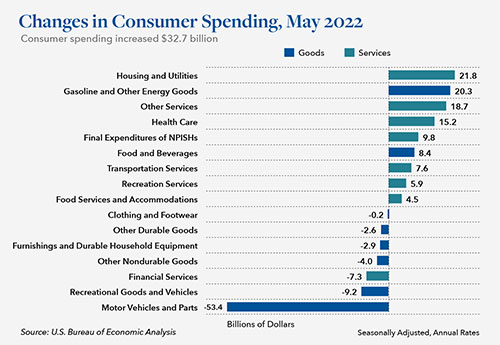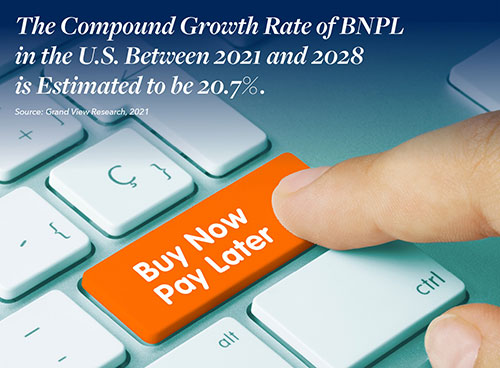A Rising Tide of Consumer Debt Warrants Precautionary Receivables Planning

In this article we discuss some of the key variables, with a focus on consumer debt and inflation, that stand to impact businesses and creditors through the balance of the year and beyond. We also explore how those with risk in their portfolios can approach the process of readiness to mitigate potential risk ahead.
It often feels like a self-fulfilling prophecy in the making when a majority of pundits start to postulate in lockstep on a singular topic. We seem to be on this type of prediction precipice right now related to the economy and its path. Whether we are heading into an acute period of slow growth, an extended decline, stagflation or a full-blown recession is an increasingly heated topic of debate.
In the first half of May, the Federal Reserve Bank of New York released its Quarterly Report on Household Debt and Credit with the following cautionary phrase in their press release, “…the first quarter of 2022 shows a solid increase in household debt…” The report point out that household debt balances are higher by $1.7 trillion than they were at the end of 2019, prior to the pandemic, and that both mortgage and auto loan balances increased during the first quarter of this year.

As product manufacturers and distributors work to factor such outlooks into their own production forecasting, creditors and lenders also have their hands full given the need to systematically evaluate the level of risk by borrowers within their portfolios, with an eye toward ensuring the ability to implement appropriate mitigation measures quickly, if and when needed.
As household debt has increased, personal savings has dropped. From December 2021 through May 2022, the personal saving rate — saving as a percentage of disposable income — declined by a significant 3.3% from 8.7% to 5.4%. Inflation and the added pressure being posed by continued high fuel prices is clearly squeezing consumers’ bank accounts. The all-item consumer price index (CPI) hit a 40-year high of 9.1 percent year-over-year in June 2022 and inflationary pressures is expected to remain elevated throughout the year.
While Fed officials expressed some optimism in regard to the longer-term path of the economy, they lowered GDP forecasts sharply and hinted at a much greater inflation surge than previously indicated. They also noted some reports of slowing consumer sales and businesses delaying previously planned investment as a precautionary measure.
Meanwhile, nine out of ten consumers surveyed in a poll concluded in early May by the Washington Post and George Mason University’s Schar School of Policy and Government said that they are feeling inflation’s pinch, with about two-thirds believing inflation is going to get worse in the next year. Inflation, of course, is regressive, and therefore costliest for those at the lower end of the income scale. Not surprisingly, those lower to middle income respondents in the survey were more likely to state that inflation is a ‘major’ financial stress on their households as compared with higher income earner respondents.
History has shown the difficulty of predicting the pace and duration of an economic slowdown. While personal outlays increased in May of this year, we saw most of that spending concentrated on services such as dining out, recreation, and travel; not surprising after two years of pandemic postponement and pent-up demand.
Consumer goods spending, however, accounted for the drag on outlays.
Decreases here extended across clothing and footwear to household furnishings, recreational goods, motor vehicles, parts and more.

For both lenders in the consumer space and those with commercial exposure across durable and non-durable goods, a notable cause for concern is the increasing average debt balance per non-prime consumer, which is up as compared with pre-pandemic levels.
These are the consumers who have little to no safety net, making them a liability warranting close lender assessment and scrutiny. According to credit reporting agency TransUnion, during the period Q1 2021 to Q1 2022, account balances for non-mortgage lending products also increased among both non-prime as well as prime and above consumers.
It is also important to note here that consumers are simultaneously experiencing an increased monthly debt service burden for both auto and personal loans in addition to their credit card accounts, with seriously delinquent rates rising in the last year for both.
Over the past several years, following the financial crisis, the mix of firms entering the consumer lending space has grown. Financial technology (Fintech) companies, for example, have been key to helping expand access to financing for historically underserved consumers and have proven highly attractive to younger consumers, often charging significantly elevated interest rates in exchange for that privilege and further contributing to overall consumer debt levels. While these fintech providers have largely focused on onboarding users, building robust platforms, and adding new services, they have also operated outside some of the rigid regulatory constraints imposed on traditional banking institutions. As a result, questions remain as to how well prepared they would be in the event that an increasing number of their customers are unable to pay their credit card minimums amid a major economic downturn.
As consumers increasingly use credit cards to pay for everyday expenses, including gasoline at the pump, and costs requiring cash on hand — such as mortgages and apartment lease payments — continue to rise, many credit experts believe a breaking point could be on the horizon. If, indeed, this is the case, a wide range of credit providers ranging from the aforementioned fintech firms to auto leasing companies, consumer electronics, appliance and other retailers stand to be directly impacted. Furthermore, the use of Buy Now, Pay Later (BNPL) installment plans by consumers as an alternative payment option for everyday purchases, not just big-ticket retail items, is on the rise.
Annual BNPL transactions are now estimated at over $100 billion and analysts suggest that based on current trends this could leap to somewhere between $1 and $4 trillion in just the next few years. This has economists and consumer advocates concerned, as the use of these services – offered by a wide range of fintech and other providers including Apple, PayPal, Affirm and Zip — could further add to the debt load of consumers moving forward.
Manufacturers, distributors and others further up the supply chain stand to feel the pinch from impacted customers as well. As a result, proactively exploring risk mitigation strategies including receivables collections readiness may be an advisable step for many at this point in time.

A LOOK AROUND THE WORLD: IS STAGFLATION LOOMING?
Of course, the global economy is driving some of the economic uncertainty in the U.S. as well. The war in Ukraine, the pandemic, and ongoing supply chain disruptions in key markets including China and elsewhere are all taking a significant toll on the global economy. The World Bank’s June forecast took some wind out of the economy’s sails, cutting its growth forecast to 2.9 percent from the 4.1 percent figure anticipated just this past January and noting that this kind of challenge has not been seen since the 1970s – a period when twin oil shocks stifled growth while prices continued to rise, leading to stagflation. The Bank’s announcement further stated that, “subdued growth will likely persist throughout the decade because of weak investment in most of the world.” The assessment for top economies such as the U.S. is that we will not escape the damage, although it is likely to be more acute in less developed parts of the world.
This is an important point because U.S. monetary and trade policy will affect both U.S. and global consumers.
As the World Bank put it, “Against the challenging backdrop of higher inflation, weaker growth, tighter financial conditions, and limited fiscal policy space, governments will need to reprioritize spending toward targeted relief for vulnerable populations.”
These pressures will most certainly affect the ability of the U.S. government to stimulate the economy and protect U.S. consumers from the downturn.
GETTING OUT AHEAD OF THE CURVE
We encourage businesses and creditors with risk in the areas described within this article to maintain a close eye on their portfolios and the overall industries in which commercial borrowers operate, paying close attention to factors including inventory levels and receivables aging. At Hilco Receivables, we are currently working on numerous engagements across a wide range of industries to provide consumer and commercial trade receivables debt monetization and valuation services — including underperforming and non- performing portfolio recovery services — to our clients in this complex economic environment. Consider reaching out to our experienced team to discuss your situation or for added perspective on a challenge you are presently facing. We are here to help.
In addition to industry-leading trade receivables debt monetization and valuation services, Hilco Receivables has the resources to acquire debt using its own capital or can readily structure a contingency fee transaction that maximizes value for a client to best serve the client’s distinct business objectives. The Hilco Receivables team has decades of experience collecting virtually every category of consumer and commercial debt across North America and Europe. We leverage that experience to help our clients realize the maximum value of their accounts receivables portfolios.




